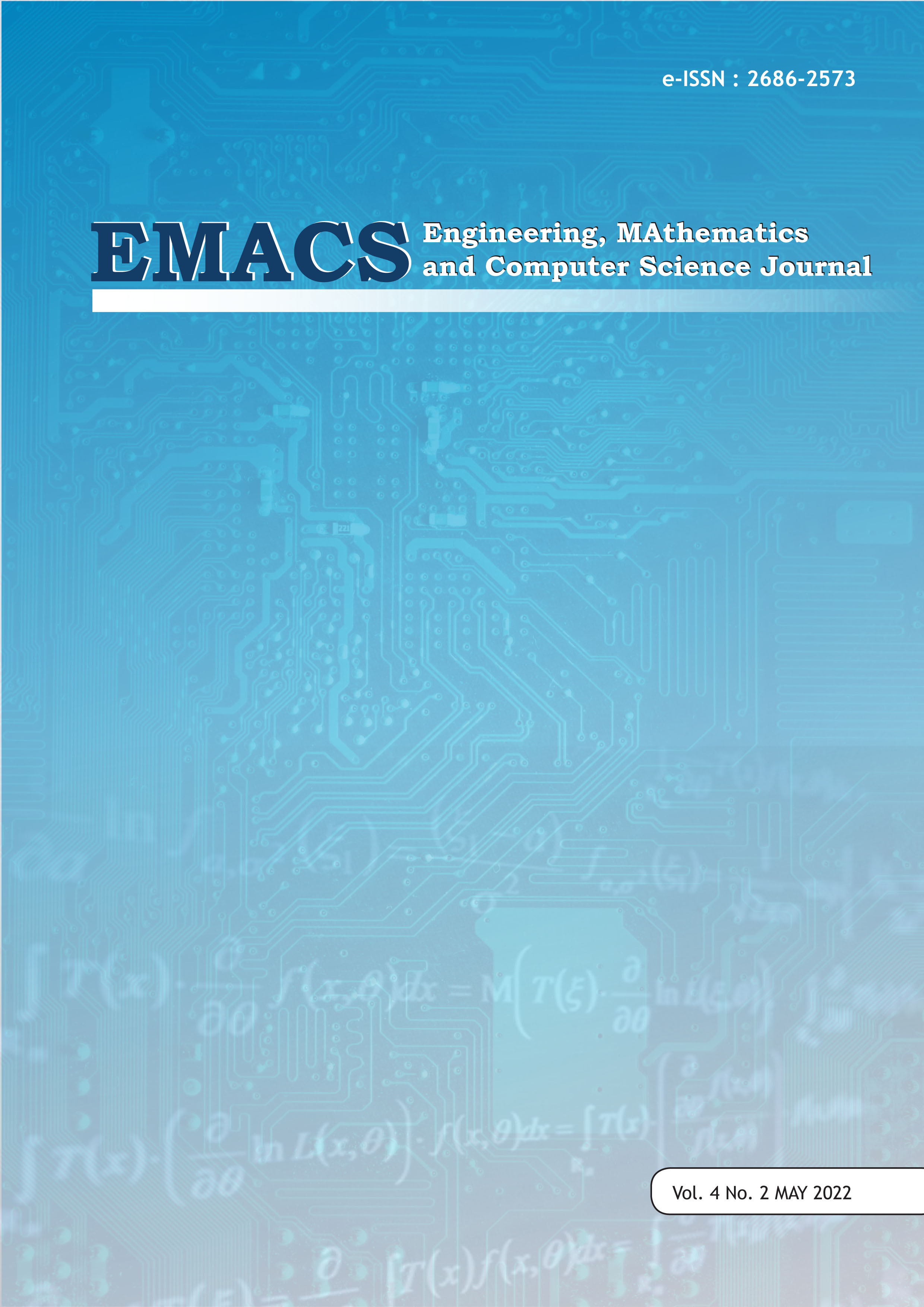The Development of E-Butler Hotel Service Robot
DOI:
https://doi.org/10.21512/emacsjournal.v4i2.8119Keywords:
E-butler Robot, Social Distancing, Service Robot, TeleconferenceAbstract
A hotel is a place that provides accommodation, food, drink, and services for people traveling far from home. During this pandemic, many hotels started to apply strict health protocols for social distancing by reducing the number of their employees. For this purpose, we developed a service robot for some works in a hotel called E-butler. E -butler robots can provide amenities delivery service for the guest. The butler application for ordering amenities was developed by using MIT App Inventor as a prototype and will be developed further using Flutter. While the hardware of the E-butler robot is developed using the Mecanum wheels platform and Arduino for controlling the movement of the robot. Furthermore, the e-butler robot is equipped with teleconference devices based on Jetson Nano to facilitate communication between hotel employees and guests. Based on our evaluation, the butler robots can carry out the main task of E-butler, which can replace human butlers in hotels.
References
Alexander A S Gunawan, Valdi Stevanus, Albertus Farley, Heri Ngarianto, Widodo Budiharto, Herman Tolle, Muhammad Attamimi. (2019). Development of Smart Trolley System Based on Android Smartphone Sensors. Procedia Computer Science, 157, 629-637.
C.R.Kothari. (2004). Research Methodology Methods and Techniques (second revised edition). Jaipur(India): New Age International Publishers.
Ernesto Ersada Barus, Suprapto, Admaja Dwi Herlambang. (2018). Analisis Kualitas WebsiteTribunnews.com Menggunakan Metode Webqual dan Importance Performance Analysis. Jurnal Pengembangan Teknologi Informasi dan Ilmu Komputer, Vol.2,No.4, hlm. 1483-1491.
Han, D., Hou, H. (Cynthia), Wu, H., & Lai, J. H. K. (2021). Modelling Tourists’ Acceptance of Hotel Experience-Enhancement Smart Technologies. Sustainability, 4462, 13(8).
Hirotaka Osawa, Arisa Ema, Hiromitsu Hattori, Naonori Akiya, Nobotsugu Kanzaki, Akinori Kubo,. (2017). Analysis of Robot Hotel: Reconstruction of Works with Robots. 2017 26th IEEE International Symposium on Robot and Human Interactive Communication (RO-MAN), 219-223.
Ivanov, S. (2020). The impact of automation on tourism and hospitality jobs. Inf Technol Tourism, 22, 205-215.
Kumar D, Malviya R, Kumar Sharma P. (2020). Corona Virus: A Review of COVID-19. Eurasian Journal of Medicine and Oncology, 8-25.
Lee, Yejin; Lee, Seunghwan; Kim, Dae-Young. (2020). Exploring hotel guests’ perceptions of using robot assistants. Tourism Management Perspectives , 37, 12. Retrieved 07 26, 2021, from https://sci-hub.ee/10.1016/j.tmp.2020.100781
Marr, B. (2019, August 05). Robots as a service: A technology trend every business must consider. (forbes) Retrieved 08 02, 2021, from https://www.forbes.com/sites/bernardmarr/2019/08/05/robots-as-a-service-a-technology-trend-every-business-must-consider/#182d90f924ea/
McRoberts, M. (2011). Beginning Arduino. Apress. Retrieved 8 2, 2021
O. Diegel, A. Badve, G. Bright et al. (2002). Improved mecanum wheel design for omni-directional robots. Shinji Kamiuchi and Shoichi Maeyama, “A Novel Human Interface of an Omni-directional Wheelchairâ€, Int. Workshop on Robot and Human Interactive Communication, 2004, pp. 101-106. (2002) (November) 27-29, 117-121.
Richard T.R Qiu, Jinah Park, ShiNa Li, Haiyan Song. (2020). Social costs of tourism during the COVID-19 pandemic. Annals of Tourism Research, 84(102994).
RoboCircuits. (2018, June 5). Line Follower Robot Arduino. Retrieved from Project Hub: https://create.arduino.cc/projecthub/robocircuits/line-follower-robot-arduino-299bae
Seongseop (Sam), K., Jungkeun, K., Frank, B.-B., Marilyn, G., & Youngjoon, C. (2020). Preference for robot service or human service in hotels? Impacts of the COVID-19 pandemic. International Journal of Hospitality Management, 1.
Sillers, P. (2017, 09 24). Robots, chatbots and augmented reality: the future of travel and the. (INDEPENDENT) Retrieved 11 15, 2021, from https://www.independent.co.uk/travel/news-and-advice/future-travel-airport-technology-hi-tech-chatbots-robots-augmented-reality-ai-a7961171.html
Smith, A. G. (2011). Introduction to Arduino. Alan G. Smith.
Yeh, S.-S. (2020). Tourism recovery strategy against COVID-19 pandemic. Torusim Recreation Research, 1-7.
Zhmud V, Kondratiev N, Kuznetsov K, Trubin V, Dimitrov L. (2018). Application of ultrasonic sensor for measuring distances in robotics. Institute of Physics Publlishing.
Downloads
Published
How to Cite
Issue
Section
License
Copyright (c) 2022 Engineering, MAthematics and Computer Science (EMACS) Journal

This work is licensed under a Creative Commons Attribution-ShareAlike 4.0 International License.
Authors who publish with this journal agree to the following terms:
- Authors retain copyright and grant the journal right of first publication with the work simultaneously licensed under a Creative Commons Attribution License - Share Alike that allows others to share the work with an acknowledgment of the work's authorship and initial publication in this journal.
- Authors are able to enter into separate, additional contractual arrangements for the non-exclusive distribution of the journal's published version of the work (e.g., post it to an institutional repository or publish it in a book), with an acknowledgment of its initial publication in this journal.
- Authors are permitted and encouraged to post their work online (e.g., in institutional repositories or on their website) prior to and during the submission process, as it can lead to productive exchanges, as well as earlier and greater citation of published work.
USER RIGHTS
All articles published Open Access will be immediately and permanently free for everyone to read and download. We are continuously working with our author communities to select the best choice of license options, currently being defined for this journal as follows: Creative Commons Attribution-Share Alike (CC BY-SA)





